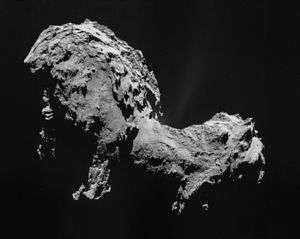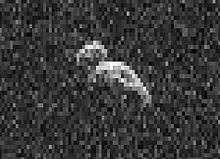67P/Churyumov–Gerasimenko
|
| |||||||||||||||||
| Discovery | |||||||||||||||||
|---|---|---|---|---|---|---|---|---|---|---|---|---|---|---|---|---|---|
| Discovered by |
Klim Ivanovich Churyumov Svetlana Ivanovna Gerasimenko | ||||||||||||||||
| Discovery site |
Alma-Ata, Kazakh SSR, Soviet Union Kiev, Ukrainian SSR, Soviet Union | ||||||||||||||||
| Discovery date | 20 September 1969 | ||||||||||||||||
| Designations | |||||||||||||||||
| 1969 R1, 1969 IV, 1969h, 1975 P1, 1976 VII, 1975i, 1982 VIII, 1982f, 1989 VI, 1988i[1] | |||||||||||||||||
| Orbital characteristics[1] | |||||||||||||||||
| Epoch 10 August 2014 (JD 2456879.5) | |||||||||||||||||
| Aphelion | 5.6829 AU (850,150,000 km) | ||||||||||||||||
| Perihelion | 1.2432 AU (185,980,000 km) | ||||||||||||||||
| 3.4630 AU (518,060,000 km) | |||||||||||||||||
| Eccentricity | 0.64102 | ||||||||||||||||
| 6.44 yr | |||||||||||||||||
| 303.71° | |||||||||||||||||
| Inclination | 7.0405° | ||||||||||||||||
| 50.147° | |||||||||||||||||
| 12.780° | |||||||||||||||||
| Physical characteristics | |||||||||||||||||
| Dimensions |
Large lobe:[2] 4.1×3.3×1.8 km (2.5×2.1×1.1 mi) Small lobe:[2] 2.6×2.3×1.8 km (1.6×1.4×1.1 mi) | ||||||||||||||||
| Volume | 18.7 km3 (4.5 cu mi)[3] | ||||||||||||||||
| Mass | (9.982±0.003)×1012 kg[3] | ||||||||||||||||
Mean density | 0.533 ± 0.006 g/cm3 (0.01926 ± 0.00022 lb/cu in)[3][4] | ||||||||||||||||
| est. 1 m/s (3 ft/s)[5] | |||||||||||||||||
| 12.4043±0.0007 h[6] | |||||||||||||||||
| 52°[2] | |||||||||||||||||
North pole right ascension | 69.3°[2] | ||||||||||||||||
North pole declination | 64.1°[2] | ||||||||||||||||
| Albedo | 0.06[2] | ||||||||||||||||
| |||||||||||||||||
|
| |||||||||||||||||
67P/Churyumov–Gerasimenko (abbreviated as 67P or 67P/C-G) is a Jupiter-family comet,[7] originally from the Kuiper belt,[8] with a current orbital period of 6.45 years,[1] a rotation period of approximately 12.4 hours[6] and a maximum velocity of 135,000 km/h (38 km/s; 84,000 mph).[9] Churyumov–Gerasimenko is approximately 4.3 by 4.1 km (2.7 by 2.5 mi) at its longest and widest dimensions.[10] It was first observed on photographic plates in 1969 by Soviet astronomers Klim Ivanovych Churyumov and Svetlana Ivanovna Gerasimenko, after whom it is named. It came to perihelion (closest approach to the Sun) on 13 August 2015.[11][12][13][14]
Churyumov–Gerasimenko was the destination of the European Space Agency's Rosetta mission, launched on 2 March 2004.[15][16][17] Rosetta rendezvoused with Churyumov–Gerasimenko on 6 August 2014[18][19] and entered orbit on 10 September 2014.[20] Rosetta's lander, Philae, landed on the comet's surface on 12 November 2014, becoming the first spacecraft to land on a comet nucleus.[21][22][23] On 30 September 2016, the Rosetta spacecraft ended its mission by landing on the comet in its Ma'at region.[24][25]
Discovery
Churyumov–Gerasimenko was discovered in 1969 by Klim Ivanovich Churyumov of the Kiev University's Astronomical Observatory,[26] who examined a photograph that had been exposed for comet Comas Solà by Svetlana Ivanovna Gerasimenko on 11 September 1969 at the Alma-Ata Astrophysical Institute, near Alma-Ata (now Almaty), the then-capital city of Kazakh Soviet Socialist Republic, Soviet Union. Churyumov found a cometary object near the edge of the plate, but assumed that this was comet Comas Solà.[27]
After returning to his home institute in Kiev, Churyumov examined all the photographic plates more closely. On 22 October, about a month after the photograph was taken, he discovered that the object could not be Comas Solà, because it was about 1.8 degrees off the expected position. Further scrutiny produced a faint image of Comas Solà at its expected position on the plate, thus proving that the other object was a different comet.[27]
Shape
The comet consists of two lobes connected by a narrower neck, with the larger lobe measuring about 4.1×3.3×1.8 km (2.5×2.1×1.1 mi) and the smaller one about 2.6×2.3×1.8 km (1.6×1.4×1.1 mi).[2] With each orbit the comet loses matter, as gas and dust are evaporated away by the sun. It is estimated that currently a layer with an average thickness of about 1 ± 0.5 m (3.3 ± 1.6 ft) is lost per orbit.[28]
The two-lobe shape of the comet is the result of a gentle, low-velocity collision of two objects. The "terraces", layers of the interior of the comet that have been exposed by partial stripping of outer layers during its existence, are oriented in different directions in the two lobes, indicating that two objects fused to form Churyumov–Gerasimenko.[29][30]
Surface
There are 19 distinct regions on Churyumov–Gerasimenko, with each named after an Egyptian deity; regions on the large lobe are named after gods, whereas those on the small lobe are named after goddesses.[31]
| Region | Terrain | Named after |
|---|---|---|
| Ma'at | Dust covered | Ma'at |
| Ash | Dust covered | Ash |
| Babi | Dust covered | Babi |
| Seth | Pitted and brittle material | Set |
| Hatmehit | Large-scale depression | Hatmehit |
| Nut | Large-scale depression | Nut |
| Aten | Large-scale depression | Aten |
| Hapi | Smooth | Hapi |
| Imhotep | Smooth | Imhotep |
| Anubis | Smooth | Anubis |
| Maftet | Rock-like | Maftet |
| Bastet | Rock-like | Bastet |
| Serqet | Rock-like | Serqet |
| Hathor | Rock-like | Hathor |
| Anuket | Rock-like | Anuket |
| Khepry | Rock-like | Khepry |
| Aker | Rock-like | Aker |
| Atum | Rock-like | Atum |
| Apis | Rock-like | Apis |
Gates
Features known as Gates, twin prominences on the surface so named for their appearance, have received names by the Rosetta Science Working Team. They are named after deceased members of the Rosetta team.[32]
| Name | Named after |
|---|---|
| C. Alexander Gate | Claudia Alexander |
| A. Coradini Gate | Angioletta Coradini |
Orbit and rotation
Like the other comets of the Jupiter family, Churyumov–Gerasimenko probably originated in the Kuiper belt and was ejected towards the interior of the Solar System, where later encounters with Jupiter successively changed its orbit.
Up to 1840, the comet's perihelion distance was 4 AU (600 million km), too far for the Sun to vaporize the nucleus. In 1840 Jupiter changed the orbit to a perihelion distance of 3 AU (450 million km), and later encounters further decreased that distance to 2.77 AU (414 million km).[33]
In February 1959, a close encounter with Jupiter[34] moved Churyumov–Gerasimenko's perihelion inward to about 1.29 AU (193 million km), where it remains today.[14][33]
Before Churyumov–Gerasimenko's perihelion passage in 2009, its rotational period was 12.76 hours. During this perihelion passage, it decreased to 12.4 hours, which likely happened because of sublimation-induced torque.[6]
2015 perihelion
As of September 2014, Churyumov–Gerasimenko's nucleus had an apparent magnitude of roughly 20.[13] It came to perihelion on 13 August 2015.[11][12] From December 2014 until September 2015, it had an elongation less than 45 degrees from the Sun.[35] On 10 February 2015, it went through solar conjunction when it was 5 degrees from the Sun and was 3.3 AU (490 million km) from Earth.[35] It crossed the celestial equator on 5 May 2015 and became easiest to see from the Northern Hemisphere.[35] Even right after perihelion when it was in the constellation of Gemini, it only brightened to about apparent magnitude 12, and required a telescope to be seen.[12] As of December 2015, the comet had a total magnitude of about 17.[13]
Exploration
.gif)
Churyumov–Gerasimenko was the destination of the Rosetta mission, launched in 2004, which rendezvoused with it in 2014 and was the first mission to land a space probe on a comet.
Advance work
As preparation for the Rosetta mission, Hubble Space Telescope pictures taken on 12 March 2003 were closely analysed. An overall 3D model was constructed and computer-generated images were created.[36]
On 25 April 2012, the most detailed observations until that time were taken with the 2-metre Faulkes Telescope by N. Howes, G. Sostero and E. Guido while it was at its aphelion.
On 6 June 2014, water vapor was detected being released at a rate of roughly 1 L/s (0.26 USgal/s) when Rosetta was 360,000 km (220,000 mi) from Churyumov–Gerasimenko and 3.9 AU (580 million km) from the Sun.[37][38] On 14 July 2014, images taken by Rosetta showed that its nucleus is irregular in shape with two distinct lobes. One explanation is that it is a contact binary formed by low-speed accretion between two comets, but it may instead have resulted from asymmetric erosion due to ice sublimating from its surface to leave behind its lobed shape. The size of the nucleus is estimated to be 3.5×4 km (2.2×2.5 mi).[17][39][40]
Rendezvous and orbit
Beginning in May 2014, Rosetta's velocity was reduced by 780 m/s (2,800 km/h; 1,700 mph) with a series of thruster firings.[17][41] Ground controllers rendezvoused Rosetta with Churyumov–Gerasimenko on 6 August 2014.[18][19] This was done by reducing Rosetta's relative velocity to 1 m/s (4 km/h; 2 mph). Rosetta entered orbit on 10 September, at about 30 km (19 mi) from the nucleus.[18][19][42]
Landing
Descent of a small lander occurred on 12 November 2014. Philae is a 100 kg (220 lb) robotic probe that set down on the surface with landing gear.[17][43] The landing site has been christened Agilkia in honour of Agilkia Island, where the temples of Philae Island were relocated after the construction of the Aswan Dam flooded the island.[44] The acceleration due to gravity on the surface of Churyumov–Gerasimenko has been estimated for simulation purposes at 10−3 m/s2,[45] or about one ten-thousandth of that on Earth.
Because of its low relative mass, landing on the comet involved certain technical considerations to keep Philae anchored. The probe contains an array of mechanisms designed to manage Churyumov–Gerasimenko's low gravity, including a cold gas thruster, harpoons, landing-leg-mounted ice screws, and a flywheel to keep it oriented during its descent.[46][47][48] During the event, the thruster and the harpoons failed to operate, and the ice screws did not gain a grip. The lander bounced twice and only came to rest when it made contact with the surface for the third time,[49] two hours after first contact.[50]
Contact with Philae was lost on 15 November 2014 because of dropping battery power. The European Space Operations Centre briefly reestablished communications on 14 June 2015 and reported a healthy spacecraft but communications were lost again soon after.[51] On 2 September 2016, Philae was located in photographs taken by the Rosetta orbiter. It had come to rest in a crack with only its body and two legs visible. While the discovery solves the question of the lander's disposition, it also allows project scientists to properly contextualise the data it returned from the comet's surface.[52]
Science
The composition of water vapor from Churyumov–Gerasimenko, as determined by the Rosetta spacecraft, is substantially different from that found on Earth. The ratio of deuterium to hydrogen in the water from the comet was determined to be three times that found for terrestrial water. This makes it unlikely that water found on Earth came from comets such as Churyumov–Gerasimenko.[8][53][54] On 22 January 2015, NASA reported that, between June and August 2014, the comet released increasing amounts of water vapor, up to tenfold as much.[55] On 23 January 2015, the journal Science published a special issue of scientific studies related to the comet.[56]
Measurements carried out before Philae's batteries failed indicate that the dust layer could be as much as 20 cm (7.9 in) thick. Beneath that is hard ice, or a mixture of ice and dust. Porosity appears to increase toward the center of the comet.[57]
The nucleus of Churyumov–Gerasimenko was found to have no magnetic field of its own after measurements were taken during Philae's descent and landing by its ROMAP instrument and Rosetta's RPC-MAG instrument. This suggests that magnetism may not have played a role in the early formation of the Solar System, as had previously been hypothesized.[58][59]
The ALICE spectrograph on Rosetta determined that electrons (within 1 km (0.6 mi) above the comet nucleus) produced from photoionization of water molecules by solar radiation, and not photons from the Sun as thought earlier, are responsible for the degradation of water and carbon dioxide molecules released from the comet nucleus into its coma.[60][61] Also, active pits, related to sinkhole collapses and possibly associated with outbursts are present on the comet.[62][63]
Measurements by the COSAC and Ptolemy instruments on the Philae's lander revealed sixteen organic compounds, four of which were seen for the first time on a comet, including acetamide, acetone, methyl isocyanate and propionaldehyde.[64][65][66] Astrobiologists Chandra Wickramasinghe and Max Wallis stated that some of the physical features detected on the comet's surface by Rosetta and Philae, such as its organic-rich crust, could be explained by the presence of extraterrestrial microorganisms.[67][68] Rosetta program scientists dismissed the claim as "pure speculation".[69] Carbon-rich compounds are common in the Solar System. Neither Rosetta nor Philae is equipped to search for direct evidence of organisms.[67] The only amino acid detected thus far on the comet is glycine, along with precursor molecules methylamine and ethylamine.[70]
Solid organic compounds were also found in the dust particles emitted by the comet; the carbon in this organic material is bound in "very large macromolecular compounds", analogous to the insoluble organic matter in carbonaceous chondrite meteorites. Scientists think that the observed cometary carbonaceous solid matter could have the same origin as the meteoritic insoluble organic matter, but suffered less modification before or after being incorporated into the comet.[71]
One of the most outstanding discoveries of the mission so far is the detection of large amounts of free molecular oxygen (O
2) gas surrounding the comet. Current solar system models suggest the molecular oxygen should have disappeared by the time 67P was created, about 4.6 billion years ago in a violent and hot process that would have caused the oxygen to react with hydrogen and form water.[72][73] Molecular oxygen has never before been detected in cometary comas. In situ measurements indicate that the O
2/H
2O ratio is isotropic in the coma and does not change systematically with heliocentric distance, suggesting that primordial O
2 was incorporated into the nucleus during the comet's formation.[72] Detection of molecular nitrogen (N
2) in the comet suggests that its cometary grains formed in low-temperature conditions below 30 K (−243.2 °C; −405.7 °F).[74]
Gallery
-
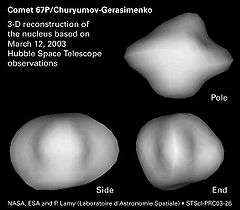
A reconstruction of the nucleus's shape based on Hubble observations in 2003
-
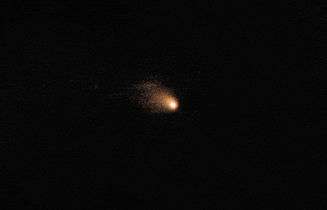
As seen by the Very Large Telescope on 11 August 2014[1]
-
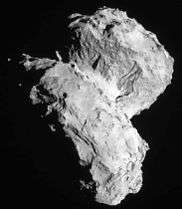
As seen by Rosetta on 22 August 2014
-

As seen by Rosetta on 14 September 2014
-

False colour image of outgassing, 15 April 2015
-

As seen by Rosetta on 7 July 2015
-

Image showing ragged cliffs, 10 December 2014
- ^ Cite error: The named reference
esobs20140908was invoked but never defined (see the help page).
See also
References
- 1 2 3 "JPL Small-Body Database Browser: 67P/Churyumov-Gerasimenko". NASA/Jet Propulsion Laboratory. 5 October 2013. Retrieved 21 January 2014.
- 1 2 3 4 5 6 7 "Comet vital statistics". European Space Agency. 22 January 2015. Retrieved 24 January 2015.
- 1 2 3 Pätzold, M.; Andert, T.; et al. (4 February 2016). "A homogeneous nucleus for comet 67P/Churyumov–Gerasimenko from its gravity field". Nature. 530 (7588): 63–65. Bibcode:2016Natur.530...63P. doi:10.1038/nature16535. PMID 26842054. Retrieved 2016-05-04.
- ↑ Lakdawalla, Emily (19 November 2015). "DPS 2015: A little science from Rosetta, beyond perihelion". The Planetary Society. Retrieved 8 December 2015.
- ↑ Dambeck, Thorsten (21 January 2014). "Expedition to primeval matter". Max-Planck-Gesellschaft. Retrieved 19 September 2014.
- 1 2 3 Mottola, S.; Lowry, S.; Snodgrass, C.; Lamy, P. L.; Toth, I.; et al. (September 2014). "The rotation state of 67P/Churyumov-Gerasimenko from approach observations with the OSIRIS cameras on Rosetta". Astronomy and Astrophysics. 569. L2. Bibcode:2014A&A...569L...2M. doi:10.1051/0004-6361/201424590.
- ↑ "List of Jupiter-Family and Halley-Family Comets". University of Central Florida: Physics. 28 July 2015. Retrieved 6 September 2015.
- 1 2 Borenstein, Seth (10 December 2014). "The mystery of where Earth's water came from deepens". Excite News. Associated Press. Retrieved 14 December 2014.
- ↑ "Rosetta's Frequently Asked Questions". European Space Agency. 2014. Retrieved 12 November 2014.
- ↑ "Bigger than you think! Comet 67P compared to cities. HD". YouTube. 12 November 2014. Retrieved 17 November 2014.
- 1 2 "Comet where spacecraft landed makes closest approach to sun". AP News. 13 August 2015. Retrieved 14 August 2015.
- 1 2 3 Yoshida, Seiichi (30 December 2010). "67P/Churyumov-Gerasimenko". Aerith.net. Retrieved 9 February 2012.
- 1 2 3 "67P/Churyumov-Gerasimenko". Minor Planet Center. Retrieved 17 June 2014.
- 1 2 Kinoshita, Kazuo (7 May 2009). "67P/Churyumov-Gerasimenko". Comet Orbit. Retrieved 25 April 2009.
- ↑ Krolikowska, Malgorzata (2003). "67P/Churyumov–Gerasimenko – potential target for the Rosetta mission". Acta Astronomica. 53: 195–209. arXiv:astro-ph/0309130
 . Bibcode:2003AcA....53..195K.
. Bibcode:2003AcA....53..195K. - ↑ Agle, D. C.; Cook, Jia-Rui; Brown, Dwayne; Bauer, Markus (17 January 2014). "Rosetta: To Chase a Comet". NASA. Release 2014-015. Retrieved 18 January 2014.
- 1 2 3 4 Chang, Kenneth (5 August 2014). "Rosetta Spacecraft Set for Unprecedented Close Study of a Comet". The New York Times. Retrieved 5 August 2014.
- 1 2 3 Fischer, D. (6 August 2014). "Rendezvous with a crazy world". The Planetary Society. Archived from the original on 6 August 2014. Retrieved 6 August 2014.
- 1 2 3 Bauer, Markus (6 August 2014). "Rosetta Arrives at Comet Destination". European Space Agency. Archived from the original on 6 August 2014. Retrieved 6 August 2014.
- ↑ Scuka, Daniel (10 September 2014). "Down, down we go to 29 km – or lower?". European Space Agency. Retrieved 20 September 2014.
- ↑ Agle, D. C.; Webster, Guy; Brown, Dwayne; Bauer, Markus (12 November 2014). "Rosetta's 'Philae' Makes Historic First Landing on a Comet". NASA. Retrieved 13 November 2014.
- ↑ Chang, Kenneth (12 November 2014). "European Space Agency's Spacecraft Lands on Comet's Surface". The New York Times. Retrieved 12 November 2014.
- ↑ "Probe makes historic comet landing". BBC News. 12 November 2014. Retrieved 12 November 2014.
- ↑ Aron, Jacob (30 September 2016). "Rosetta lands on 67P in grand finale to two year comet mission". New Scientist. Retrieved 1 October 2016.
- ↑ Gannon, Megan (30 September 2016). "Goodbye, Rosetta! Spacecraft Crash-Lands on Comet in Epic Mission Finale". Space.com. Retrieved 1 October 2016.
- ↑ "Klim Ivanovich Churyumov". International Astronomical Union. Retrieved 8 August 2014.
- 1 2 Kronk, Gary W.; Meyer, Maik (2010). "67P/1969 R1 (Churyumov-Gerasimenko)". Cometography: A Catalog of Comets; Volume 5: 1960–1982. Cambridge University Press. pp. 241–245. ISBN 978-0-521-87226-3.
- ↑ Bertaux, Jean-Loup (November 2015). "Estimate of the erosion rate from H
2O mass-loss measurements from SWAN/SOHO in previous perihelions of comet 67P/Churyumov-Gerasimenko and connection with observed rotation rate variations". Astronomy & Astrophysics. 583. A38. Bibcode:2015A&A...583A..38B. doi:10.1051/0004-6361/201525992. - ↑ Lemonick, Michael D. (28 September 2015). "Why Comet 67P Looks Like a Rubber Ducky". National Geographic. Retrieved 29 September 2015.
- ↑ Massironi, Matteo; Simioni, Emanuele; Marzari, Francesco; Cremonese, Gabriele; Giacomini, Lorenza; et al. (28 September 2015). "Two independent and primitive envelopes of the bilobate nucleus of comet 67P". Nature. 526 (7573): 402–405. Bibcode:2015Natur.526..402M. doi:10.1038/nature15511.
- ↑ Cofield, Calla (19 July 2015). "Gods Among the Stars: Why Egyptian Names Grace Comet 67P". Space.com. Retrieved 12 April 2016.
- ↑ Taylor, Matt (28 September 2015). "Rosetta Science Working Team dedication to deceased colleagues". European Space Agency. Retrieved 2 October 2015.
- 1 2 "Rosetta's target: comet 67P/Churyumov-Gerasimenko". European Space Agency. 7 October 2015. Retrieved 14 August 2016.
- ↑ "JPL Close-Approach Data: 67P/Churyumov-Gerasimenko". NASA/Jet Propulsion Laboratory. 29 June 2010. Retrieved 9 February 2012.
- 1 2 3 "Elements and Ephemeris for 67P/Churyumov-Gerasimenko". Minor Planet Center. Retrieved 9 August 2014.
- ↑ Buckley, Michael; Villard, Ray; Christensen, Lars (5 September 2003). "Hubble Assists Rosetta Comet Mission". HubbleSite.org.
- ↑ Baldwin, Emily (23 June 2014). "First Detection of Water from 67P/C-G". European Space Agency. Retrieved 23 June 2014. Sungrazer Comets at Twitter.com.
- ↑ Agle, D. C.; Brown, Dwayne; Bauer, Markus (30 June 2014). "Rosetta's Comet Target 'Releases' Plentiful Water". NASA. Retrieved 30 June 2014.
- ↑ "The twofold comet: Comet 67P/Churyumov-Gerasimenko". Astronomy.com. 17 July 2014. Retrieved 18 July 2014.
- ↑ Temming, Maria (17 July 2014). "Rosetta's Comet has a Split Personality". Sky & Telescope. Retrieved 18 July 2014.
- ↑ Gannon, Megan (4 August 2014). "Comet-chasing Euro-probe could make history Wednesday". The Christian Science Monitor. Retrieved 6 August 2014.
- ↑ Lakdawalla, Emily (15 August 2014). "Finding my way around comet Churyumov-Gerasimenko". The Planetary Society. Archived from the original on 15 August 2014. Retrieved 15 August 2014.
- ↑ Chang, Kenneth (10 November 2014). "Philae Lander Nears a Cosmic Touchdown". The New York Times. Retrieved 11 November 2014.
- ↑ Amos, Jonathan (4 November 2014). "Rosetta comet mission: Landing site named 'Agilkia'". BBC News. Retrieved 9 November 2014.
- ↑ Hilchenbach, M. (2004). Simulation of the Landing of Rosetta Philae on Comet 67P/Churyumov-Gerasimenko (PDF). SIMPACK User Meeting. 9–10 November 2004. Wartburg/Eisenach, Germany. p. 25. Retrieved 6 August 2014.
- ↑ Ellis, Ralph (13 November 2014). "Space probe scores a 310-million-mile bull's-eye with comet landing". CNN. Retrieved 13 November 2014.
Comet 67P has a very weak gravity, so anchoring harpoons were designed to shoot into the comet to fix the spacecraft to the surface.
- ↑ Parnell, Brid-Aine (12 November 2014). "Bouncy bouncy: Comet probot Philae may have landed twice". The Register. Retrieved 13 November 2014.
Philae's flywheel was part of its landing gear and stopped the craft from rotating while it was operational, but it was switched off once the probot indicated it had touched down.
- ↑ O'Neill, Ian (12 November 2014). "Rosetta's Lander Grabs Onto Comet and Lands". Discovery News. Retrieved 13 November 2014.
As there was a real risk of the lander bouncing off the comet, harpoons, landing leg ice screws and thrusters needed to work in concert to ensure Philae stayed in place.
- ↑ Agle, D. C.; Brown, Dwayne; Bauer, Markus (13 November 2014). "Rosetta's Comet Lander Landed Three Times". NASA. Retrieved 13 November 2014.
- ↑ Beatty, Kelly (12 November 2014). "Philae Lands on Its Comet – Three Times!". Sky & Telescope. Retrieved 26 November 2014.
- ↑ Biever, Celeste; Gibney, Elizabeth (14 June 2015). "Philae comet lander wakes up and phones home". Nature. doi:10.1038/nature.2015.17756. Retrieved 14 June 2015.
- ↑ Beatty, Kelly (5 September 2016). "Finally, ESA Locates Comet Lander Philae". Sky & Telescope. Retrieved 10 September 2016.
- ↑ Agle, D. C.; Bauer, Markus (10 December 2014). "Rosetta Instrument Reignites Debate on Earth's Oceans". NASA. Retrieved 10 December 2014.
- ↑ Chang, Kenneth (10 December 2014). "Comet Data Clears Up Debate on Earth's Water". The New York Times. Retrieved 10 December 2014.
- ↑ Agle, D. C.; Brown, Dwayne; Bauer, Markus (22 January 2015). "Rosetta Comet 'Pouring' More Water Into Space". NASA. Retrieved 22 January 2015.
- ↑ "Catching a Comet". Science. Special Issue. 347 (6220). 23 January 2015. Retrieved 23 January 2015.
- ↑ Baldwin, Emily (18 November 2014). "Philae settles in dust-covered ice". European Space Agency. Retrieved 18 December 2014.
- ↑ Bauer, Markus (14 April 2015). "Rosetta and Philae Find Comet Not Magnetised". European Space Agency. Retrieved 14 April 2015.
- ↑ Schiermeier, Quirin (14 April 2015). "Rosetta's comet has no magnetic field". Nature. doi:10.1038/nature.2015.17327.
- ↑ Agle, D. C.; Brown, Dwayne; Fohn, Joe; Bauer, Markus (2 June 2015). "NASA Instrument on Rosetta Makes Comet Atmosphere Discovery". NASA. Retrieved 2 June 2015.
- ↑ Feldman, Paul D.; A'Hearn, Michael F.; Bertaux, Jean-Loup; Feaga, Lori M.; Parker, Joel Wm.; et al. (2 June 2015). "Measurements of the near-nucleus coma of comet 67P/Churyumov-Gerasimenko with the Alice far-ultraviolet spectrograph on Rosetta" (PDF). Astronomy and Astrophysics. 583: A8. arXiv:1506.01203
 . Bibcode:2015A&A...583A...8F. doi:10.1051/0004-6361/201525925.
. Bibcode:2015A&A...583A...8F. doi:10.1051/0004-6361/201525925. - ↑ Vincent, Jean-Baptiste; et al. (2 July 2015). "Large heterogeneities in comet 67P as revealed by active pits from sinkhole collapse". Nature. 523 (7558): 63–66. Bibcode:2015Natur.523...63V. doi:10.1038/nature14564.
- ↑ Ritter, Malcolm (1 July 2015). "It's the pits: Comet appears to have sinkholes, study says". Associated Press. Retrieved 2 July 2015.
- ↑ Jordans, Frank (30 July 2015). "Philae probe finds evidence that comets can be cosmic labs". The Washington Post. Associated Press. Retrieved 30 July 2015.
- ↑ "Science on the Surface of a Comet". European Space Agency. 30 July 2015. Retrieved 30 July 2015.
- ↑ Bibring, J.-P.; Taylor, M.G.G.T.; Alexander, C.; Auster, U.; Biele, J.; Finzi, A. Ercoli; Goesmann, F.; Klingehoefer, G.; Kofman, W.; Mottola, S.; Seidenstiker, K.J.; Spohn, T.; Wright, I. (31 July 2015). "Philae's First Days on the Comet – Introduction to Special Issue". Science. 349 (6247): 493. Bibcode:2015Sci...349..493B. doi:10.1126/science.aac5116. Retrieved 30 July 2015.
- 1 2 Ratcliffe, Rebecca (5 July 2015). "Philae comet could be home to alien life, say scientists". The Guardian. Retrieved 6 July 2015.
- ↑ "Alien Life On Philae Comet, Scientists Say". Sky News. 6 July 2015. Retrieved 6 July 2015.
- ↑ Knapton, Sarah (6 July 2015). "Alien life 'unlikely' on Rosetta comet, say mission scientists". The Daily Telegraph. Retrieved 6 July 2015.
- ↑ Altwegg, Kathrin; Balsiger, Hans; Bar-Nun, Akiva; Berthelier, Jean-Jacques; Bieler, Andre; et al. (27 May 2016). "Prebiotic chemicals—amino acid and phosphorus—in the coma of comet 67P/Churyumov-Gerasimenko". Science Advances. 2 (5). e1600285. Bibcode:2016SciA....2E0285A. doi:10.1126/sciadv.1600285. PMC 4928965
 . PMID 27386550.
. PMID 27386550. - ↑ Fray, Nicolas; Bardyn, Anaïs; Cottin, Hervé; Altwegg, Kathrin; Baklouti, Donia; et al. (7 September 2016). "High-molecular-weight organic matter in the particles of comet 67P/Churyumov–Gerasimenko". Nature. doi:10.1038/nature19320. PMID 27602514.
- 1 2 Bieler, A.; et al. (29 October 2015). "Abundant molecular oxygen in the coma of comet 67P/Churyumov–Gerasimenko". Nature. 526 (7575): 678–681. Bibcode:2015Natur.526..678B. doi:10.1038/nature15707. PMID 26511578.
- ↑ Howell, Elizabeth (October 28, 2015). "Modern Mystery: Ancient Comet Is Spewing Oxygen". Space.com. Retrieved 2015-11-06.
- ↑ Rubin, M.; Altwegg, K.; Balsiger, H.; Bar-Nun, A.; Berthelier, J.-J.; et al. (April 2015). "Molecular nitrogen in comet 67P/Churyumov-Gerasimenko indicates a low formation temperature". Science. 348 (6231): 232–235. Bibcode:2015Sci...348..232R. doi:10.1126/science.aaa6100.
- "VLT Tracks Rosetta's Comet". European Southern Observatory. 8 September 2014. Retrieved 8 September 2014.
Further reading
- Agarwal, Jessica; et al. (June 2010). "The dust trail of Comet 67P/Churyumov–Gerasimenko between 2004 and 2006". Icarus. 207 (2): 992–1012. arXiv:1001.3775
 . Bibcode:2010Icar..207..992A. doi:10.1016/j.icarus.2010.01.003.
. Bibcode:2010Icar..207..992A. doi:10.1016/j.icarus.2010.01.003. - Corum, Jonathan (30 April 2015). "Rosetta Is Tailing a Warming Comet". The New York Times.
External links
| Wikimedia Commons has media related to 67P/Churyumov-Gerasimenko. |
- 67P/Churyumov–Gerasimenko at Cometography.com
- 67P/Churyumov–Gerasimenko at the Wayback Machine (archived 11 November 2007) by the Instituto de Astrofísica de Canarias
- 67P/Churyumov–Gerasimenko pronunciation guide by the European Space Agency
- Articles
- "Rosetta's Target: Comet 67P/Churyumov–Gerasimenko" by the European Space Agency
- "Mission to Land on a Comet" by NASA
- Media
- Churyumov–Gerasimenko image gallery by the European Space Agency
- ESA's Rosetta image gallery at Flickr.com
- Churyumov–Gerasimenko size comparison by the European Space Agency
- Rosetta: landing on a comet by the European Space Agency
| Numbered comets | ||
|---|---|---|
| Previous 66P/du Toit |
67P/Churyumov–Gerasimenko | Next 68P/Klemola |
